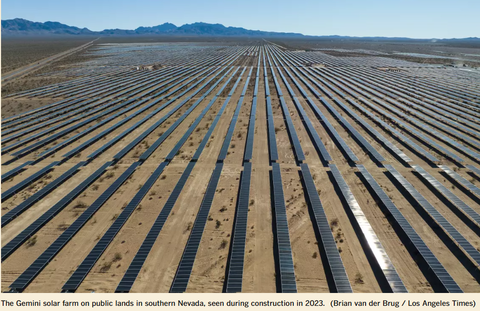Chris Edwards
In 2025, the new Congress and incoming Trump administration should reassess the sprawling 2022 Inflation Reduction Act (IRA), which handed out vast subsidies for green energy. One reason to reassess is that the cost of the law has ballooned from $390 billion over 10 years to more than $1 trillion.
The budget cost of green energy is not the only cost. In the effort to reduce CO2, the IRA subsidies for wind power, solar power, batteries, and electric vehicles are creating negative side effects, including harm to the environment.
One concern is the vast land area the Biden administration plans to cover with solar photovoltaic (PV) panels. In August, the administration proposed a Western Solar Plan, which “would make over 31 million acres of public lands across 11 Western states available for potential solar development.”
Many Americans have put PV panels on their homes and businesses, which seems like a good use of rooftop space on private properties. But do Americans know that the government is planning to smother a huge area of our Western public lands with metal and glass PV infrastructure?
Of the 31 million acres of Bureau of Land Management (BLM) lands, the administration proposes that PV panels cover 700,000 acres, which is 538,000 football fields. As I understand it, those acres will be bulldozed to set up the PV structures, thus pushing aside plants and animals. For example, a new PV project in the Mojave Desert in California threatens thousands of Joshua trees and habitat for desert foxes. The project’s power will be consumed a couple hundred miles away in Silicon Valley.
Huge PV installations could get in the way of animal migrations. One PV facility in Wyoming was constructed “across a primary pronghorn migration corridor. Thousands of the ungulates were forced off their natural migration path and onto the highway.” PV facilities could also interfere with bird migrations: “Researchers hypothesize that birds confuse shiny solar panels for bodies of water when flying over the desert, a theory called ‘lake effect.’ Birds change their flight to land on the panels and can die when attempting to land.”
The Biden PV plan is supposed to mitigate damage to wildlife, but it seems likely that covering 700,000 acres with metal and glass boxes and support beams, and connecting them to vast new power lines, will cause environmental damage.
Covering huge swaths of open lands with PV structures also undercuts the aesthetic value of this shared resource of people in the West. Yet, strangely, numerous environmental groups support the Biden plan and include photos on their websites of PV infrastructure covering beautiful natural landscapes (such as here and here).
Some Western leaders are pointing out that BLM lands are supposed to be managed for multiple uses, yet solar PV structures monopolize the lands they cover. Other Westerners see the administration’s top-down solar plan as a threat to state sovereignty. The Salt Lake Tribune reported, “Feds want to open 1/10th of Utah for solar energy development. The state and environmentalists aren’t so sure.”
Solar power sounds green, and in many ways it is. But there is also a physical reality to it that is becoming more apparent as its negative footprint expands.
What is the best solution for solar power in the West? That should be for Westerners to decide. Most federal lands should be transferred to the ownership of state governments. They are better placed to make environmental and economic trade-offs for their residents than the distracted government in faraway Washington.
I examine reforms to BLM lands here. Some articles providing a balance of views on the Western solar issue are here, here, and here.
